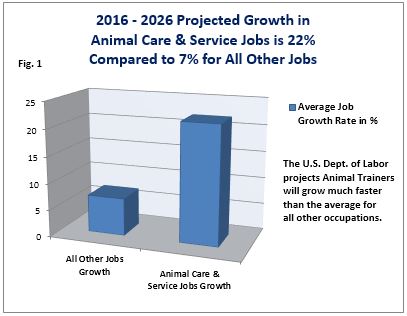Dog Training Careers are on the Rise
“Go confidently in the direction of your dreams. Live the life you have imagined.”
-Henry David Thoreau
 Now is a very exciting time to pursue a dog training career. The dog training industry continues to grow rapidly and it is becoming more professionalized each year. Dog training and care services are tied to a very strong pet industry whose passionate customers spend money because they want the best for their beloved animals.
Now is a very exciting time to pursue a dog training career. The dog training industry continues to grow rapidly and it is becoming more professionalized each year. Dog training and care services are tied to a very strong pet industry whose passionate customers spend money because they want the best for their beloved animals.
Research shows that becoming a dog trainer offers a great opportunity for you to be successful. Read on below for the details.
11 Reasons Why Pet Services is a Smart Industry to Join Right Now
- The U.S. Dept of Labor projects that the employment of animal care and service workers, and specifically animal trainers, is projected to continue growing from 2016 to 2026, faster than the average for all occupations. The Bureau of Labor Statistics reports that Animal care and service workers will continue to be needed as the variety and number of pet services increases.1 See Figure 1 below.
 The 2020-2030 U.S. Outlook for Animal Care and Service Workers states that “many people consider their pets to be a part of their family and are willing to pay more for pet care than pet owners have in the past. As more households include companion pets…employment of animal care and service workers in kennels, grooming shops, and pet stores is projected to increase in order to keep up with the growing demand for animal care.”1
The 2020-2030 U.S. Outlook for Animal Care and Service Workers states that “many people consider their pets to be a part of their family and are willing to pay more for pet care than pet owners have in the past. As more households include companion pets…employment of animal care and service workers in kennels, grooming shops, and pet stores is projected to increase in order to keep up with the growing demand for animal care.”1- A recent AlphaWise survey reported that “almost two-thirds of 18-to-34-year-olds plan to get a pet in the next five years, driving a 14% increase in pet ownership.” They believe that “pet owners, especially younger ones, will spend more – increasing annual household spending from $980 per pet to $1,909 by 2030.”2
- According to the 2021-2022 National Pet Owners Survey provided by the American Pet Products Association, “70% of U.S. households own a pet, which equates to 90.5 million homes.”10
- “All over the country, from New York to Wisconsin and North Carolina to Colorado and New Mexico, animal shelters are reporting massive upswings in the numbers of animals they’ve been able to adopt out or place in foster homes” – Kitty Block, president and CEO of the Humane Society of the United States.3
- Adweek magazine writes, “A surge in animal fostering, adoptions and purchases has been followed by a boom in consumer interest in pet products and services.” Suzanne McDonnell, chief commercial officer and head of ventures and partnerships at Bark said, “History has shown us that people actually spend more on their pets in an economic downturn.”4 The American Kennel Club estimated that “the number of U.S. households that have at least one dog (69 million homes) increased to 54% in 2020 from 50% in 2018.”2
- The pet industry has been experiencing explosive growth. According to The American Pet Products Association, almost 90.5 million households have a pet and over the last 33 years pet ownership has gone from 56% to 70% of all households.10 The AKC also states that “doggy daycares experienced a growth in the percentage of owners who used their services – from 22% to 28%.”2
- The Association of Professional Dog Trainers (APDT) has seen their annual conference grow from just 250 participants a few years ago to 1,500 participants. The APDT membership has grown at a similar rate with over 6,000 members in 48 countries, the APDT is the largest association of dog trainers world-wide.6 The AKC has also reported that “training devices and methods (including treats) saw a surge, with 73% [of pet owners] reporting [the use of] some type of training method in 2020 vs. 57% in 2018.”2
- Time Magazine writes, “Nowadays, 80% of owners view their pets as family members, according to a survey by the American Veterinary Medical Association (AVMA).” Not only that, but they “also consider pets as the next step to actually starting their own human family. They consider their pets as an outward extension of themselves and their own personalities, so they want to be seen together, be it on social media, on trips, errands, even at the workplace,” said American Pet Products Association President Bob Vetere.7
- “America is pet obsessed. Pet ownership is up. Spending on pets is up. In fact, we actually spend more on our pets during a recession. Pet-care spending even grew during the past two recessions: 29% during the 2001 recession and 17% during the 2008-09 recession…This all points to a solid, recession-proof industry. It means pet-care companies enjoy predictable cash flows and sales growth.”8
- “U.S. retail sales of pet products and services reached $107 billion in 2020, up 9% over 2019, due largely to a COVID-19 driven spike in pet population.”9
1 – Bureau of Labor Statistics, U.S. Department of Labor
2 – American Kennel Club
3 – Wired Magazine
4 – Adweek
5 – Forbes Online
6 – Association of Professional Dog Trainers
7 – Time Magazine
8 – Market Watch
9 – Packaged Facts: U.S. Pet Market Outlook, 2021-2022
10 – American Pet Products Association







 Phone:
Phone: